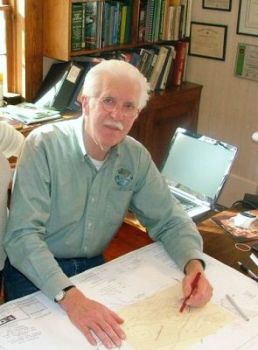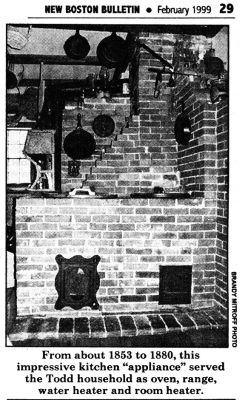New Boston Historical Society
New Boston, New Hampshire

Todd's Corner
 Robert Todd has written his monthly column "In the Country" for the New Boston Bulletin
since the first issue of our town's only newspaper was published in 1998.
Bob is a forester, a land surveyor, and a historian whose family has lived in New Boston for 200 years.
The Todd homestead in New Boston is on the Francestown Road at Todd's Corner.
Robert Todd has written his monthly column "In the Country" for the New Boston Bulletin
since the first issue of our town's only newspaper was published in 1998.
Bob is a forester, a land surveyor, and a historian whose family has lived in New Boston for 200 years.
The Todd homestead in New Boston is on the Francestown Road at Todd's Corner.
Bob Todd's columns reflect his interests in nature, history and philosophy. We linked to these pages every column Bob could find on his computer, about 10-12 columns per year. For each year's collection of articles, we highlight below those of particular interest to historians, with brief quotes from the columns.
Click on links like "1998 collection" to view the corresponding PDF in a new window. Again, the PDF for a given year will contain all the columns for that year, not just those with a historical focus.
We thank Bob and the New Boston Bulletin's editor Brandy Mitroff for permission to reproduce Bob's columns! (2022 update: Robert B. Todd, Jr. passed in 2021; his editor Brandy Mitroff passed in 2022. Both are greatly missed.)
1998 collection
A Legacy of a New Boston Native (3/98?) about the chestnut tree: Settlers in New Boston and the southern New Hampshire region were dependent on the many gifts from the fast growing chestnut tree. At the time of New Boston's settlement, the period of 1735 to about 1780, chestnut held a position of dominance in most of the forest. To the settlers chestnut was one of the most favored woods for construction of homes and furnishings. Often the beams, shingles, siding, and inside paneling for a single house were all from this easily milled wood.
Patterns on the Land (4/98) about homesteads and stone walls: The pattern on the New Boston landscape owes its integrity, to an astonishing degree, to the existence of miles and miles of stonewalls built upon the lot lines... It is said that a crew of two men with a pair of oxen and a gallon of hard cider could build about one rod of wall per day. By calculation, 35,000 crew days were required to build the walls marking the original lot lines. In addition, 35,000 gallons of cider would have been consumed, enough to more than fill one of the Fire Department's cisterns.
A Pharmacy in the Forest (9/98) about plant-based medicines: "Take a handful of ground willow bark in warm water and call me in the morning". This may have been regular advice given by early Native American medicine men... Since the beginnings of civilization man has looked to trees and other plants for medicine to cure his ills.
Crooked Highways and a Straight Turnpike (12/98) about the 2nd NH Turnpike: Look over a map of New Boston and note the existence of the Turnpike in the southwest corner of town. The Pike runs northwesterly from the Mont Vernon line straight to the Lyndeborough line. Its siting is not now, nor ever has it been, a route convenient, or necessary for providing New Boston residents access "to market, to meeting, and to mill".
 1999 collection
1999 collectionA Kitchen Anthology (2/99) about an old brick oven: My understanding of how the oven was used is limited to a vague memory of someone's story (probably Grandmother Bessie, the last cook known to use it) that a fire was built in the oven and allowed to burn for several hours, thus heating the brick chamber walls. The pies, breads, and other foods were then, with the aid of a long handled wooden or wrought iron peel, placed inside to bake, usually overnight.
2000 collection
Rare and Endangered Old Buildings (2/2000) about a map and old farm buildings: With each name and location the map annotated the scope of agricultural endeavor. Cows, hens, vegetables, potatoes, maple syrup, fire wood, berries and fruit were all inventoried... I noticed that in a majority of my recollections the old farms have vanished completely.
Cranberries, Canals, and Water Rights (6/2000) about an old cranberry meadow: My family first occupied the farm in 1814 and I know that nothing was thrown away - it stayed on the wall, or stacked in the corners, from one generation to the next and I represented the fifth generation to look upon these things.
The Importance of Place (10/2000) about New Boston hills, rivers and rocks: The Frog Rock likeness has been on postcards widely distributed during a time when folks came from the city to the country to "summer" in hilltop hotels in the area.
My Reverence for Wood (11/2000) about things made from wood: Ever since I was a child I have dreamed of having a birch bark canoe... Bark canoes were to the Native Americans what the pickup truck is to current society. European settlers were amazed at the speed and maneuverability of the natives' sleek canoe.
2001 collection
A Rewarding Vocation (1/2001) about early surveyors: Mathew Patten was instrumental in facilitating the settlement of New Boston as well. The proprietors of New Boston hired Mathew to lay out the meetinghouse lot in 1763. His journal entry for this engagement on July 11 of that year reads "I sett out for New Boston to help fix a place for to build their Meeting House on the other Committee man was Capt. Chamberlin and my brother".
New Boston Boys in the Gold Rush (8/2001) about an ancestor's adventures: While cleaning a closet I found a bag with a gold nugget and several medicine vials filled with gold dust. Further "cleaning" uncovered a watercolor rendering of a placer mining site on which was written "Mining Claim, J.P. Todd and Co., Sonora California, 1850."
Community Service: Past and Present (11/2001) from hog reeve to road agent: Following is a list of officers that were appointed at the March town meeting in 1835: 1 pound keeper; 1 sealer of weights and measures; 17 surveyors of lumber; 12 hog reeves; 40 surveyors of highways; 1 culler of staves; 1 sealer of leather; 4 surveyors of wood and bark; 3 fence viewers, and; 3 field drivers.
Bob's columns written after 2001 may be found on the next page.
